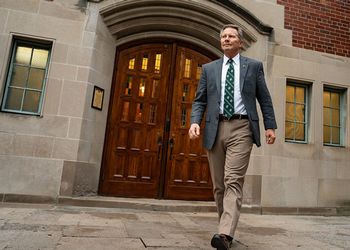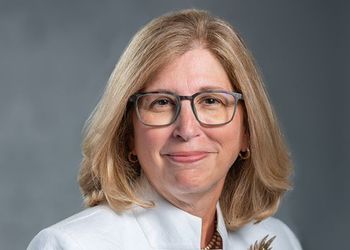Feature: MSU's College of Human Medicine is Making a Bold Move Westward

MSU intends to build a medical school for the 21st century with a bold move to the west.
The phrase “win-win” has become so over-used it now borders on the cliché.
But sometimes it just seems like the right thing to say.
And other times it’s even more appropriate to take it one step further by saying a certain situation is “win-win-win.”
That seems to be the case here in which MSU’s College of Human Medicine (CHM) is continuing to move forward with its plan to expand into West Michigan.
As the pieces, and there are a lot of them, continue to fall into place, it’s becoming obvious that the expansion will make winners of not only the people of West Michigan, who will enjoy the benefits of a major medical school right in their own backyard, but also the people who live in the East Lansing area, and the people of the entire state of Michigan.
“CHM will be a larger, stronger college by developing a four-year school in Grand Rapids and that will increase research opportunities in Lansing for CHM and other MSU colleges,” says Marsha Rappley, CHM’s acting dean. “In the long-term, it will improve patient care by speeding the translation of the cutting-edge medical research into patient care in all of CHM’s campuses. In fact, this will benefit patients across Michigan.”
MSU’s two medical colleges are community based, meaning MSU medical students, including those in CHM and the College of Osteopathic Medicine (COM), spend their first two years on campus, and years three and four in a community-based medical setting.
CHM has six community campuses, located in Lansing, Grand Rapids, Flint, Saginaw, Kalamazoo and the Upper Peninsula. COM has affiliations with hospitals throughout the state, ranging from the Detroit area to Traverse City.
It was more than two years ago that the idea of an MSU medical school presence in West Michigan began to form during discussions between MSU and West Michigan community leaders.
As time moved along, the plan began to take shape, more West Michigan partners became involved, and even a time frame began to come together.
Under the plan, the number of first-year medical students at MSU’s East Lansing campus will increase by approximately 50, bringing the total number of first-year students to 150. That is scheduled to happen in 2007.
In 2008, those 50 students would then move to Grand Rapids. The four-year school is expected to be fully operational by 2010 with an entering class of 100 students.
One of the biggest challenges that Rappley and other college officials have had to deal with is the misperception that the school in East Lansing is actually moving to Grand Rapids.
“The medical school in East Lansing will remain a full, four-year school with its current faculty and a robust faculty practice plan, continuing to serve the mid-Michigan community,” Rappley says.
What is being established in Grand Rapids is an entirely new, four-year medical school program. This school will be formed out of significant partnerships with Spectrum Health, Saint Mary’s Health Care, the Van Andel Institute, Grand Valley State University and West Michigan community physicians.
“The College of Human Medicine will remain one college with one dean,” Rappley emphasized.
“What an exciting thing for West Michigan and Michigan State to be partners in what is a truly rare opportunity,” says MSU President Lou Anna Simon. “Building on MSU’s long-standing presence in the community, we are committed to creating a research intensive, patient-centered four-year medical school, one that is embedded in the community.”
“We are committed to making this endeavor a success for both the university and Grand Rapids,” says Richard Breon, president and CEO of Spectrum Health. “We want to build something here that will outlast all of us. We want to establish a West Michigan medical school that will exist for decades and continue to grow in significance.”
"Saint Mary's Health Care looks forward to working with Michigan State University in bringing its medical school to Grand Rapids for several reasons,” says Philip H. McCorkle, Jr., Saint Mary’s president and CEO. “It will enhance our opportunities to identify the most beneficial and cost effective methods of care that can improve the health of our community; it will increase our ability to attract physicians from national centers of excellence, especially in difficult-to-recruit specialties; and it will provide improved access to treatments, technology, and research needed by The Lacks Cancer Center and The Hauenstein Center at Saint Mary's.
“Overall, we believe that this effort is good for our patients, and good for our community."
Once up and running, the new school will be research intensive, focusing much of its efforts on biomedical research. Five research “clusters” have been identified: cancer, obesity, cardiovascular disease, arthritis and neurobiology.
“The college’s substantial Michigan funding base, its geographic location, and its strong interest in expanding medical research made it the natural partner in fulfilling our vision,” says David Van Andel, chairman and CEO of Grand Rapids’ Van Andel Institute, one of several West Michigan partners in the project.
Earlier this year, the MSU Board of Trustees unanimously adopted a resolution authorizing the administration to “implement the expansion of the college”—in essence, telling the college to go forth and expand.
“This is truly a vision and a mandate for the future of medical education, not only for West and mid Michigan, but for the entire nation,” Simon said at the time. “This is a model others can turn to as medical education faces the challenges of the future.”
Looking for new ways to do things—whether it’s preparing tomorrow’s physicians, providing health care in the communities where people live, and even changing the way doctors and patients communicate—has been a hallmark of the college since its founding in the 1960s.
For Rappley, it’s all about staying true to the values that the college’s faculty, staff and students strongly believe in so dearly, while striving for a new level of distinction and accomplishment.
“A key value is being well integrated into our communities,” she notes. “Each community is a partner in all of our efforts, bringing a richness to our education, our research and our service.”
As the college continues its plans to expand into West Michigan, it will mean different things to different people.
For some physicians, such as Gilbert Padula, a radiation oncologist at Grand Rapids’ St. Mary’s Health Care, it will be an opportunity to expand his research opportunities, especially in the area of clinical research.
“If we can keep our patients close to Grand Rapids, we could have a greater emphasis on clinical research,” says Padula, who also is the president of the CHM Alumni Board. “With resources close at hand, the patients have less reason to travel to participate in clinical trials.”
He also noted that with affiliations with partners such as the Van Andel Institute, the college’s basic research mission will be enhanced.
“With the medical school and basic research getting even more closely tied together,” he notes, “what’s done at the bench will readily translate to the bedside.”
For other West Michigan doctors, such as family physician David Kutsche, the expansion will ultimately mean better care for his patients.
“I envision that as CHM builds its presence in West Michigan, we will begin to see more sub-specialists,” he says. “We’ll also see more cutting-edge research that can eventually be passed along to our patients.”
He offered this example: “One of my patients is a young girl with stomach problems whose parents have to drive her back and forth to Ann Arbor. Eventually they will be able to stay right here in Grand Rapids and get the care they need and deserve.”
Kutsche is a 1984 graduate of CHM and past president of the college’s alumni board. Padula is a 1997 graduate of the school.
For CHM Acting Dean Rappley, the West Michigan expansion offers an opportunity to make a great medical school even greater.
“We are already among the best of the community-based medical schools,” she says. “Now it’s time for us to jump tiers and be among the best of all medical schools.”
MSU’S COLLEGE OF OSTEOPATHIC MEDICINE ALSO LOOKS TO EXPAND—TO THE SOUTHEAST
MSU’s College of Human Medicine isn’t the only MSU medical college looking to expand its horizons.
In 2005, the College of Osteopathic Medicine (MSUCOM), addressing the severe physician shortage that is expected by 2020, expanded its incoming class size from 147 to 205.
“When you add up the four years of undergraduate education with a student’s time in medical school, plus postdoctoral studies, it takes a minimum of 10 years to train a doctor from start to finish,” says MSUCOM Dean William D. Strampel. “When you’re working with that type of timeline, you have to start addressing a physician shortage early on by expanding the size of each incoming class.”
The college is also aggressively pursuing the creation of a satellite campus in southeast Michigan, Strampel says.
“We’re planning to teach 50 additional students in each class at an off-campus site in southeastern Michigan,” he notes.
The final plans are still being hashed out and will need approval of the American Osteopathic Association and the MSU administration and Board of Trustees.
The benefits of a southeast Michigan expansion are numerous.
Fourteen of the 24 hospitals that comprise the college’s Statewide Campus System are located in that region of the state.
The site is expected to act as a catalyst for programs designed to address the medical needs of the underserved.
And, it’s expected to increase the number of MSUCOM student recruits from that area.
With as many as 38 percent of Michigan physicians expected to return within the next decade, COM’s expansion into southeast Michigan is viewed as critical to providing for the future needs of Michigan residents.
“Two-thirds of our graduates decide to establish their practice in the state,” Strampel says. “With that kind of track record, we can clearly play a pivotal role in addressing the physician shortage here.”



